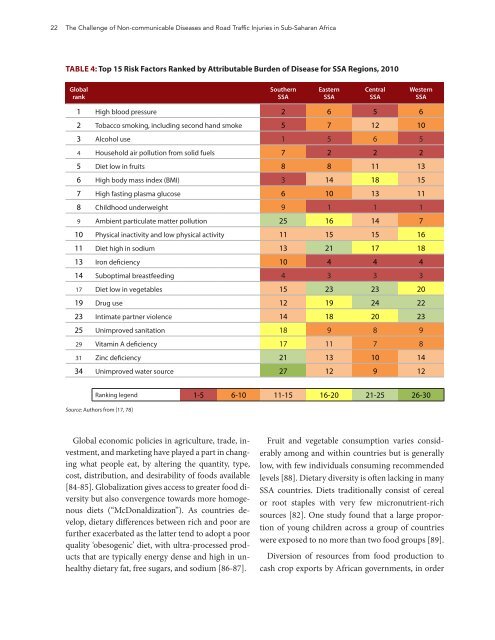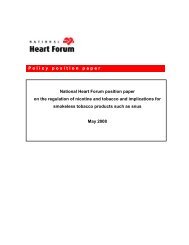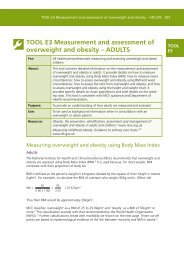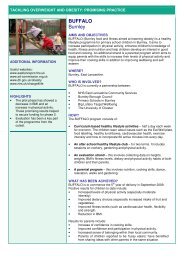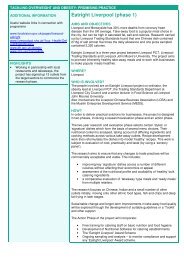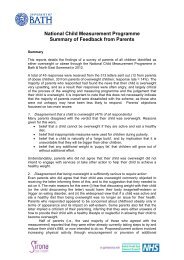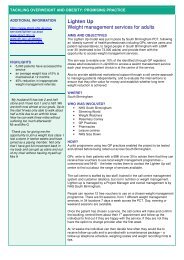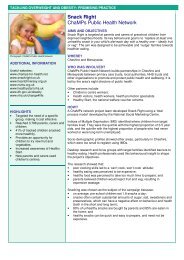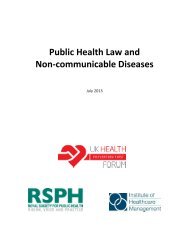The Challenge of Non-Communicable Diseases and Road Traffic ...
The Challenge of Non-Communicable Diseases and Road Traffic ...
The Challenge of Non-Communicable Diseases and Road Traffic ...
You also want an ePaper? Increase the reach of your titles
YUMPU automatically turns print PDFs into web optimized ePapers that Google loves.
22 <strong>The</strong> <strong>Challenge</strong> <strong>of</strong> <strong>Non</strong>-communicable <strong>Diseases</strong> <strong>and</strong> <strong>Road</strong> <strong>Traffic</strong> Injuries in Sub-Saharan Africa<br />
TABLE 4: Top 15 Risk Factors Ranked by Attributable Burden <strong>of</strong> Disease for SSA Regions, 2010<br />
Global<br />
rank<br />
Southern<br />
SSA<br />
Eastern<br />
SSA<br />
Central<br />
SSA<br />
Western<br />
SSA<br />
1 High blood pressure 2 6 5 6<br />
2 Tobacco smoking, including second h<strong>and</strong> smoke 5 7 12 10<br />
3 Alcohol use 1 5 6 5<br />
4 Household air pollution from solid fuels 7 2 2 2<br />
5 Diet low in fruits 8 8 11 13<br />
6 High body mass index (BMI) 3 14 18 15<br />
7 High fasting plasma glucose 6 10 13 11<br />
8 Childhood underweight 9 1 1 1<br />
9 Ambient particulate matter pollution 25 16 14 7<br />
10 Physical inactivity <strong>and</strong> low physical activity 11 15 15 16<br />
11 Diet high in sodium 13 21 17 18<br />
13 Iron deficiency 10 4 4 4<br />
14 Suboptimal breastfeeding 4 3 3 3<br />
17 Diet low in vegetables 15 23 23 20<br />
19 Drug use 12 19 24 22<br />
23 Intimate partner violence 14 18 20 23<br />
25 Unimproved sanitation 18 9 8 9<br />
29 Vitamin A deficiency 17 11 7 8<br />
31 Zinc deficiency 21 13 10 14<br />
34 Unimproved water source 27 12 9 12<br />
Ranking legend 1-5 6-10 11-15 16-20 21-25 26-30<br />
Source: Authors from [17, 78]<br />
Global economic policies in agriculture, trade, investment,<br />
<strong>and</strong> marketing have played a part in changing<br />
what people eat, by altering the quantity, type,<br />
cost, distribution, <strong>and</strong> desirability <strong>of</strong> foods available<br />
[84-85]. Globalization gives access to greater food diversity<br />
but also convergence towards more homogenous<br />
diets (“McDonaldization”). As countries develop,<br />
dietary differences between rich <strong>and</strong> poor are<br />
further exacerbated as the latter tend to adopt a poor<br />
quality ‘obesogenic’ diet, with ultra-processed products<br />
that are typically energy dense <strong>and</strong> high in unhealthy<br />
dietary fat, free sugars, <strong>and</strong> sodium [86-87].<br />
Fruit <strong>and</strong> vegetable consumption varies considerably<br />
among <strong>and</strong> within countries but is generally<br />
low, with few individuals consuming recommended<br />
levels [88]. Dietary diversity is <strong>of</strong>ten lacking in many<br />
SSA countries. Diets traditionally consist <strong>of</strong> cereal<br />
or root staples with very few micronutrient-rich<br />
sources [82]. One study found that a large proportion<br />
<strong>of</strong> young children across a group <strong>of</strong> countries<br />
were exposed to no more than two food groups [89].<br />
Diversion <strong>of</strong> resources from food production to<br />
cash crop exports by African governments, in order


